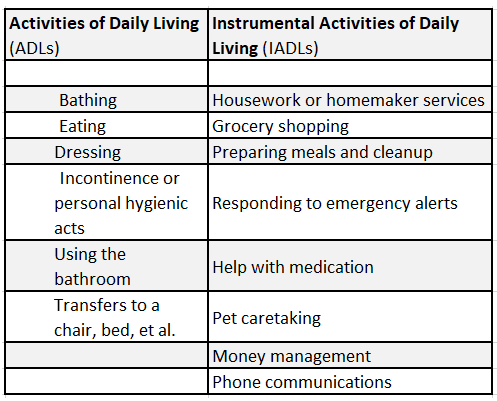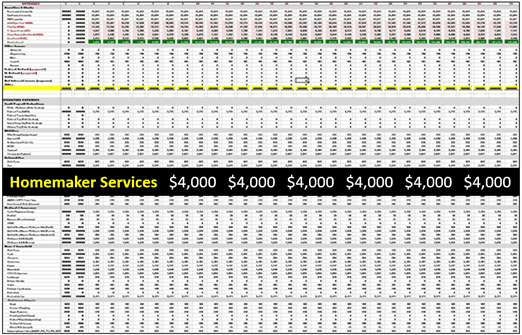Retirement Planning for Long-Term Care

Making a plan to cover your long-term care needs in retirement is one of the most difficult issues you will face. No one knows what will be required in the future.
Some experts, such as Christine Benz with Morningstar, believe the probability can be quite high. In one of its bulletins (in which it also interviewed Benz), AARP estimates a 50 percent chance of someone needing some form of long-term care (LTC) at age 65 and beyond.
Of course, these statistical forecasts might not end up reflecting your personal situation. The truth? The answer may range anywhere from a price tag of zero to the need of skilled nursing care that costs hundreds of thousands of dollars over several years.
As fuzzy as that picture is, you can still plan effectively for the future potential costs of long-term care, not to mention other healthcare expenses.
Long-Term Care Planning with Spouses
Hopefully we all have a significant other we are sharing our lives with at the start of retirement. As we age gracefully and make our way through the arc of retirement, this trusted partner will be your first primary caregiver.
If you have good genes, exercise daily, eat and sleep well, and have lady luck on your side, there might be good news.
You may be able to navigate most of your retirement by one partner taking care of the other without any major long-term care needs and costs. This optimistic scenario includes a baseline of (mostly routine) healthcare costs that in your 30-year retirement plan (PLAN.xls).
Caring for Each Other
This would assume that your healthcare needs would be covered by a combination of Medicare and supplemental health insurance coverage. For some people, it may even include some coverage by Medicaid.
While you are both physically and cognitively healthy, you can support each other with what the LTC industry calls “Activities of Daily Living” (ADLs) and “Instrumental Activities of Daily Living” (IADLs):

However, some researchers with the Department of Health & Human Services have estimated you might need outside help. Their findings?
There might be a 50% chance you might need some level of LTC services at some point in retirement, once you no longer can provide the ADL and IADL support yourself.
So, best plan for some outside help.
Gather Some Realistic Long-Term Care Cost Data
The first step in developing an LTC plan is to gather the most accurate and current service provider cost data available.
Just as you do when looking for a good plumber, keep your ear to the ground during every conversation. You might pick up good information about what these kinds of services cost in your region, and who are the good providers.
Follow this up with direct calls to providers to get their current costs for services. But, for starters, the following are ballpark costs from a recent Genworth “Cost of Care” survey:
- Adult Day Healthcare: $1,500/month
- Assisted Living Facility: $3,750/month
- Homemaker Services: $4,000/month
- Home Health Aide: $4,100/month
- Nursing Home: $7,600/month
Be advised, these costs can vary substantially depending upon where you live in the country.
Scenario Planning with Your Retirement Plan
You may choose to first do this yourself, or in collaboration with your financial professional. Save a copy of your retirement plan (“PLAN.xls”), and you might rename it as “PLAN-LTC.xls”.
Using the cost data you have assembled, run separate scenarios to see how they impact your baseline retirement budget (no LTC costs). For example:
- Scenario #1: Add a line item for “Adult Day Healthcare,“ $1,500/month, 1 year; or,
- Scenario #2: Add a line item for “Home Health Aide Services,” $4,100/month, 2 years; or,
- Scenario #3: Add a line item for “Nursing Home,” $7,600/month, 3 years; or,
- Scenario #4: ?

You might assume that these services are for one partner in the couple. In this scenario, the other partner might not need these services but couldn’t provide the ADL and IADL support themselves.
As you can see, this iterative process of testing scenarios can be done many ways. However, for all of us, there is no way to know what will actually come to pass.
But you can test the ability of your retirement resources accumulated to date, to absorb these future costs without significantly compromising your retirement security.
Based on the outlook from your Scenario Testing in your plan, say you and your financial professional believe that there could be substantial risk down the road if you don’t additionally insure against this risk.
Then you should ask the financial professional to recommend some insurance/annuity options that will definitely help cover probable future LTC costs.
Additional Options to Fund Future LTC Services
Your SafeMoney financial professional can present the following (and more) financial instruments that will fund LTC future costs to whatever target amounts and year(s) you select. These options include:
- Long-term care insurance that offers traditional coverage for long-term care needs
- New-generation life insurance policies with living benefits
- Asset based long-term care policies that can provide tax-free benefits
Here, you are comparing:
- paying LTC insurance premiums today for guaranteed payouts in the future;
vs,
- investing those LTC premiums yourself (self-insuring) with the hope that this strategy will perform financially at least as well over time as the LTC insurance
This is a complicated calculation that involves your tolerance for economic risk (stock market volatility) and many other factors.
Developing Your Long-Term Care Strategy
Your financial professional has the knowledge and experience to talk you though this. They can help you apply sound decision-making principles to your unique set of conditions.
Just remember, this guideline can help you weather the storm and possibly bring you more peace of mind. Keep your spending in retirement equal to or less than what you earn every year of retirement; always reinvest the annual surplus; and you and your partner will be fine.
Putting a Long-Term Care Strategy into Action
Do you need help evaluating your potential long-term care needs in retirement — and different options that can be a viable strategy for your situation? Or perhaps you would like a second look at your existing long-term care strategy.
Either way, financial professionals at SafeMoney.com can assist you. You can request financial guidance by visiting our “Find a Financial Professional” section and connecting with someone directly. Should you need a personal referral, call us at 877.476.9723.








